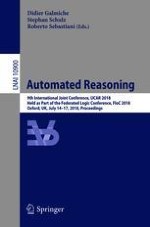This book constitutes the refereed proceedings of the 9th International Joint Conference on Automated Reasoning, IJCAR 2018, held in Oxford, United Kingdom, in July 2018, as part of the Federated Logic Conference, FLoC 2018. In 2018, IJCAR unites CADE, TABLEAUX, and FroCoS, the International Symposium on Frontiers of Combining Systems, and, for the fourth time, is part of the Federated Logic Conference.
The 38 revised full research papers and 8 system descriptions presented together with two invited talks were carefully reviewed and selected from 108 submissions. The papers focus on topics such as logics, deductive systems, proof-search methods, theorem proving, model checking, verification, formal methods, and program analysis.
